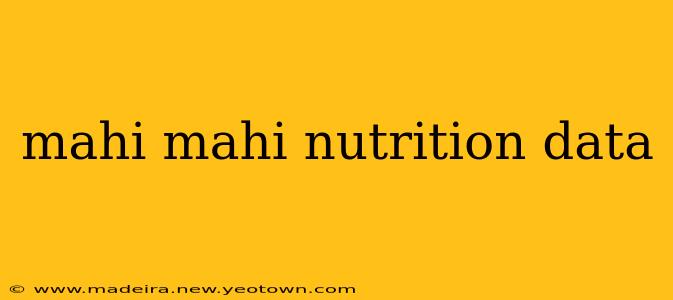Mahi-mahi, also known as dolphinfish (despite not being related to dolphins!), is a popular seafood choice prized for its firm, flaky texture and mild, slightly sweet flavor. But beyond its delicious taste, mahi-mahi boasts a nutritional profile that makes it a healthy addition to your diet. Let's dive into the detailed nutritional data and explore some frequently asked questions.
What are the nutritional benefits of mahi-mahi?
Mahi-mahi is a lean protein source, packed with essential nutrients. A 3-ounce serving provides a significant amount of protein, crucial for building and repairing tissues, and it's relatively low in fat, making it a good choice for those watching their calorie intake. But the benefits extend beyond protein. This delightful fish is a fantastic source of several B vitamins, including niacin and vitamin B6, vital for energy metabolism and nerve function. It’s also rich in selenium, a powerful antioxidant that protects cells from damage. Finally, mahi-mahi offers a decent dose of omega-3 fatty acids, beneficial for heart health and brain function.
How many calories are in mahi-mahi?
The calorie count in mahi-mahi varies slightly depending on the preparation method, but generally, a 3-ounce serving contains around 150-170 calories. This relatively low calorie count, combined with its high protein content, makes it a satisfying and weight-management-friendly option. Remember that added oils or butter during cooking can significantly increase the calorie content.
Is mahi-mahi high in mercury?
This is a question many people have, and it's an important one. The mercury content in fish can vary based on factors such as the fish's size and location. Mahi-mahi generally falls into the category of fish with a moderate mercury level. While not as low as some other fish, it's still considered safe for consumption by most adults in moderation. Pregnant women, breastfeeding mothers, and young children, however, should be more cautious and consult their doctor or a registered dietitian about their mahi-mahi intake, as they are more vulnerable to the effects of mercury.
What are the best ways to prepare mahi-mahi?
The versatility of mahi-mahi makes it a chef's delight! Its delicate flavor pairs beautifully with a variety of seasonings and cooking methods. Grilling, baking, pan-searing, and even ceviche are all excellent choices. Experiment with different herbs, spices, and marinades to discover your favorite way to savor this delicious fish. Remember to avoid overcooking, as it can result in a dry texture.
Is mahi-mahi a good source of omega-3 fatty acids?
Yes, mahi-mahi provides a decent amount of omega-3 fatty acids, though perhaps not as much as some other fatty fish like salmon. However, the omega-3s it does contain contribute to its overall health benefits. These healthy fats play an important role in reducing inflammation, supporting heart health, and maintaining healthy brain function.
What are the potential health risks associated with eating mahi-mahi?
While generally safe and nutritious, some potential risks exist. As mentioned earlier, mercury content is a factor to consider, particularly for vulnerable populations. Additionally, like any seafood, there’s a risk of consuming contaminated fish if it isn't sourced and handled responsibly. Always choose seafood from reputable sources and ensure it's cooked to a safe internal temperature to minimize these risks.
Conclusion: Enjoying Mahi Mahi Responsibly
Mahi-mahi offers a delicious and nutritious way to incorporate lean protein and essential nutrients into your diet. By being mindful of the mercury content and choosing sustainably sourced fish, you can enjoy this flavorful seafood with confidence as part of a healthy and balanced eating plan. Remember to consult a healthcare professional or registered dietitian if you have specific dietary concerns or restrictions.

